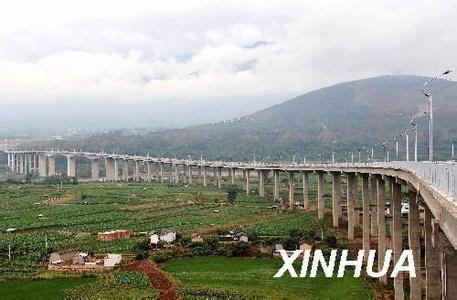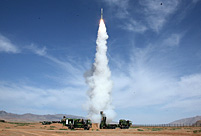 |
| (Xinhua) |
The Greater Mekong Subregion (GMS) is a natural economic area bound together by the Mekong River, covering 2.6 million square kilometers and a combined population of around 326 million.The GMS countries are Cambodia, the People's Republic of China (PRC, specifically Yunnan Province and Guangxi Zhuang Autonomous Region), Lao People's Democratic Republic (Lao PDR), Myanmar, Thailand, and Vietnam. In 1992, with assistance from ADB, the six countries entered into a program of subregional economic cooperation, designed to enhance economic relations among the countries. The Greater Mekong Subregion designates a development project formed by the Asian Development Bank The region is considered a significant biodiversity hotspot by Conservation International and the WWF.
The Mekong River, an important transnational river in Asia of a total length of 4880 kilometers, originates from the Tanggula Mountain Range on Qinghai-Tibet Plateau, running through Qinghai Province, Tibet Autonomous Region and Yunnan Province of China as well as Myanmar, Laos, Thailand, Cambodia and Vietnam from north to south, and flows from the vicinity of Ho Chi Minh City, Vietnam into the South China Sea. The section of the Mekong River within the Chinese border is called the Lancang River.
The region has a diverse geographic landscape including massifs, plateaus and limestone karsts, lowlands, fertile floodplains and deltas, forests(evergreen and semi-evergreen, deciduous, dipterocarp, mangroves, and swamp), and grasslands. Water environments include fast-flowing rocky mountainstreams and wetlands (such as Tonlé Sap in Cambodia).
The region's geographic variety and consequent variety of climatic zones support significant biodiversity, with more than 1068 new species discovered during the last ten years. The geographic region encapsulates 16 of the WWF Global 200 ecoregions, and habitats for an estimated 20000 plant species, 1300 fish species, 1200 bird species, 800 reptile and amphibian species, and 430 mammal species. Notable species include the Javan rhino, Irrawaddy dolphins, and Mekong giant catfish (one of the largest freshwater fish).
The region's biodiversity is ranked as a top-five most threatened hotspot by Conservation International. The WWF cites accelerating economic development, population growth and increased consumption patterns as primary causes, including agricultural deforestation, logging and illegal timber trade, wildlife trade, overfishing, dam and road construction, and mining. The WWF also states that the region is particularly vulnerable to global climate change.
GMS cooperation is project-oriented and provides financial and technological support as per the actual needs of member countries of the region. Since its initiation, GMS cooperation has concentrated on five strategic fields, namely, infrastructure construction, cross-border trade and investment, participation by private sectors, human resource development, and environmental protection and sustainable utilization of natural resources. Till the end of 2007, 10 billion dollars had been spent on 180 cooperation projects in nine key fields, namely, transportation, energy, telecommunications, environment, agriculture, human resource development, tourism, trade facilitation, and investment, lending great momentum to the economic and social development of GMS countries. Of these cooperation projects, 34 were investment projects costing a total of 9.87 billion dollars, of which 3.426 billion dollars were supplied by ADB and 2.98 billion and 3.466 billion respectively by GMS members and other development partners. The other 146 projects were technological aid projects which cost a total of 166 million dollars, of which 75.79 million dollars were granted by ADB.
Since its inception in 1992, the GMS program has helped bring an area once divided by conflict increasingly together with investments of about $14 billion in projects with broad subregional benefits, including roads, airports and railways; telecommunications; energy; urban development; tourism; environmental protection; and the prevention of communicable diseases.
Since the start of the economic cooperation program, gross domestic product growth in the subregion has averaged about 8% a year, while real per capita incomes tripled between 1993 and 2010. As of September 2011, the ADB assistance for the program totaled about $5 billion.
Yunnan Province has 15 ethnic minorities that live across the border between Yunnan and the neighboring countries, so the people have had a long tradition of exchange and communication with the people in other GMS countries. As for leading industries, Yunnan concentrates on tobacco, hydraulic power, nonferrous metals, steel, mineral exploitation, chemical, and development of biological resources. In terms of these industries,the province enjoys a leadership in Southwest China and even in the whole country and is quite complementary with the other GMS countries.
Thanks to the support and guidance from the central government, since the second GMS summit, the cooperative relations between Yunnan and related GMS countries have continuously been deepened and the bilateral cooperation has proceeded steadily in various fields. The construction of infrastructures such as roads, railways, navigation facilities, airports, ports, and power and telecommunications facilities has proceeded smoothly, and the facilities already built have operated effectively. The cooperation projects in the sectors of agricultural development, environmental protection, tourism, health, and human resource development have been comprehensively implemented.
Yunnan Province is a main part of China's participation in the GMS cooperation and it has been actively pushing forward the development of GMS cooperation.
 National Plug In Day celebrated in Washington D.C.
National Plug In Day celebrated in Washington D.C. New model of indigenous surface-to-air missiles testfired
New model of indigenous surface-to-air missiles testfired  118.28-carat diamond to be auctioned in HK
118.28-carat diamond to be auctioned in HK Maternal love under streetlight
Maternal love under streetlight Naked foreign student sits in the middle of a road in Haikou
Naked foreign student sits in the middle of a road in Haikou  Colorful Yunnan: Enjoy the natural beauty
Colorful Yunnan: Enjoy the natural beauty Harbin named Chinese city with most beautiful women
Harbin named Chinese city with most beautiful women For last four students, teacher couple sticks to post on island
For last four students, teacher couple sticks to post on island  When big sport stars were kids
When big sport stars were kids PLA's 38th Group Army conduct training
PLA's 38th Group Army conduct training People mourn for victims of mall attack
People mourn for victims of mall attack The last days of Wan Aihua
The last days of Wan Aihua Highlights at 12th National Games of China
Highlights at 12th National Games of China Beijing Film Academy welcomes freshmen
Beijing Film Academy welcomes freshmen Large mahjong party sets new world record
Large mahjong party sets new world recordDay|Week|Month